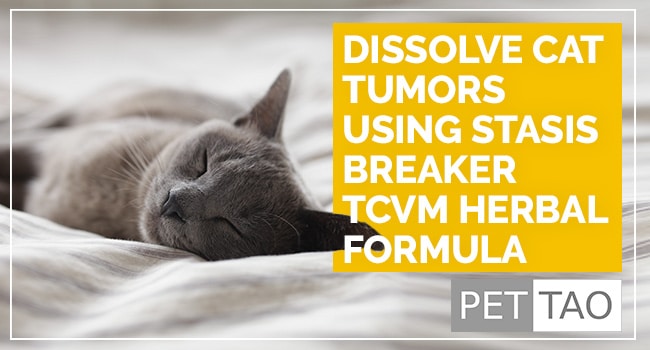Do You Need Help With Cat Tumors?
As cats age, they often develop tumors.
Cat tumors, also called neoplasia, various types of abnormal growths caused by uncontrolled cell division.
The neoplastic cells (tumor cells) do not behave and are not self-regulated like normal cells.
Cat tumor cells may live longer and/or divide faster than regular cells and can be cancerous or noncancerous.
Benign cat tumors are noncancerous tumors. Benign tumors do not spread to other body parts and rarely fatal.
Malignant cat tumors are cancerous. Malignant tumors invade and destroy surrounding tissues, spreading to other parts of the body.
Common causes of cat tumors are:
- Abscesses
- Adenomas
- Basal cell tumors
- Fatty tumors
- Fibrosarcoma
- Lymphoma
- Mast cell tumors
- Osteosarcoma
- Sebaceous cysts
- Squamous cell carcinoma
- Warts
Luckily, Eastern medicine offers a natural, herbal solution for cat tumors.
Stasis Breaker: Western Medicine Applications
Stasis Breaker, a TCVM (Traditional Chinese Veterinary Medicine) herbal blend, treats neoplasia (new abnormal growth of tissues), nodules and tumors.
Even though Stasis Breaker is a TCVM herb, it still helps with symptoms of Western diagnoses.
Stasis Breaker helps cats with the following Western diagnoses:
- Internal abnormal masses
- Nodules
Stasis Breaker: Eastern Medicine Applications
Eastern medicine treats a disease’s root cause(s) rather than symptoms.
Accordingly, TCVM vets use a different evaluation process than Western veterinarians.
TCVM vets look for signs of imbalance.
Stasis Breaker helps cats with the following TCVM signs:
- Blood stagnation/stasis
- Choppy or weak pulse
- Enlargement or nodules of local glands or internal organs in strong animals
- Purple Tongue
- Tumors or neoplasia
Note: Stasis Breaker should not be used in weak or pregnant animals.
How Stasis Breaker Treats Cat Tumors
Stasis Breaker is a TCVM blend of six different Eastern herbs.
The herbs perform synergistically, balancing systems and meridians in the body.
Stasis Breaker addresses the underlying causes of your cat’s illness or disease.
The underlying cause of a disease is imbalance somewhere in the body.
Stasis Breaker alleviates your cat’s imbalances while dissolving and preventing tumors.
According to Traditional Chinese Medicine, Stasis Breaker heals by:
- Breaking Blood stasis
- Softens the hardness of tumors
- Clears the enlargement
What Are the Ingredients in Stasis Breaker?
The main ingredients in Stasis Breaker are:
- Bai Hua She She Cao (Oldenlandia) inhibits cell mutation and tumor growth
- Ban Zhi Lian (Scutellaria) clears Heat-toxin, inhibits cell mutation, and inhibits tumor growth
- E Zhu (Zedoaria) purges the interior, breaks Blood stasis and clears masses
- Mu Li (Shu) (Ostrea) to softens hardness and clears mass
- San Leng (Sparganium) purges the interior, break stasis and clears masses
- Zhe Bei Mu (Fritillaria) to softens hardness and clears nodules
Dr. Huisheng Xie, the founder of the Chi Institute in Reddick, FL, created Stasis Breaker specifically for animals.
Dr. Xie based the Stasis Breaker herbal formula on the ancient TCM formula Nei Xiao Wan found in the text Wei Sheng Bio Jan (Precious Mirror of Health) written in 1279-1368 by Luo Tian Yi in Yuan dynasty.
Stasis Breaker works best when combined with, plenty of water, Eastern Food Therapy, and moderate exercise.
Get Stasis Breaker at TCVM Pet Supply
More Powerful Tools for Overcoming Cat Cancer Challenges
You might not be aware, but many cancer-fighting tools are easy to get and use at home.
To realize your true cancer-fighting potential:
- Learn more about cat cancer.
- Boost your cat’s immune system with medicinal mushrooms. PET | TAO’s Complement Immune Mushroom Blend blends together the most powerful immune-boosting medicinal mushrooms on the market in a single product.
- Ease your cat’s stomach upset naturally. Many cats with cancer suffer stomach upset as well. PET | TAO’s Harmonize GI naturally provides all the digestive enzymes and probiotics your cat needs for optimum gut health.
- Try PET | TAO Freeze Dried Beef Spleen Treats. According to TCVM, spleen helps with digestion and assimilation. Both are challenges often faced by pets suffering from cancer. As few as 5-6 treats per day can make a huge difference in your cat’s health!
- Try a Blood-building TCVM Diet. According to TCVM theory, cats suffering from cancer also often suffer from Blood deficiency. Blood deficiency may due to chemotherapy or the cancer itself. See PET | TAO’s Blood Building Cat Food Recipe
- Learn more about TCVM Herbal Remedies. Chinese medicine offers many amazing natural solutions for cat cancer challenges and palliative care. Some good examples are:
Get A Phone Consultation with One of Our TCVM Veterinarians
Note: Information on this site is provided for educational purposes only and is not meant to substitute the advice provided by your own veterinarian.








